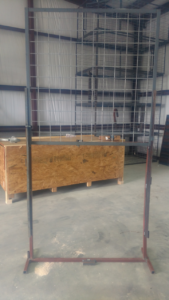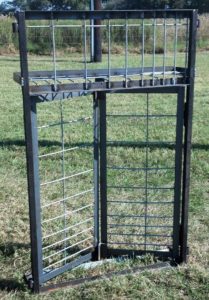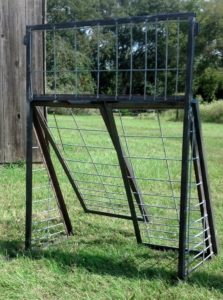One of the most common questions I’m asked is which type of hog trap door is best in a wild hog corral trap. There really isn’t a “best” door, they all have pros and cons and it really comes down to a matter of personal preference. I’m going to briefly go through the different types of doors along with their advantages and disadvantages so that you can decide which door you like best.
Guillotine Door 
The guillotine door raises up to create an opening into your trap and falls straight down when it’s activated. This is not a “continuous trapping” door, once it;s closed, it’s closed until you come and manually open it or reset it. I personally prefer the guillotine door as it generally has a bigger opening and it is positively closed with an active latch to prevent pigs from rooting it open once latched. The disadvantages are that cattle and deer are more likely to enter the trap when you have a larger opening so you have an increased risk of trapping off target animals when using an animal activated trigger. You can deter cattle and deer from entering by placing a strand of barbed wire across the opening about 3′ off the ground, feral pigs will go right under it. If you’re using a cellular controlled door trigger, this becomes a non-issue and the only potential disadvantage to using the guillotine door is that it isn’t continuous trapping. A study done at Auburn University in 2014 found that continuous trapping doesn’t happen all that often, so losing that ability may not be that much of a drawback. You can read that study here.
Saloon Doors
Saloon Doors open into the trap and close against each other when activated. They are held closed in a V shape by a pair of springs and will allow continuous catching. I sell more saloon doors for corral traps than any other style because of their ability to be continuous. The opening on our saloon doors is a little shorter than the guillotine door so you’re less likely to have deer or cattle go into the trap through the door. Since they aren’t positively closed with a latch, there is always the possibility that a smart pig will figure out that it can hold the door open and allow the other pigs out or that it will find a way to open it from the inside. I’ve never had a situation like this reported to me with the corral traps however, I have had people tell me that they’ve seen sows hold open the swing doors on box traps to let their piglets go in and eat the corn and then exit under the mother. I don’t personally believe that this is happens frequently enough for it to be a real concern but, I mention it anyway in the interest of full disclosure. While my preference is the guillotine door, I wouldn’t hesitate to set a trap up with a set of saloon doors if that’s what I had available.
 Root Door
Root Door
Of all the doors, the root door is my least favorite because it can create a ramp inside the trap to allow pigs to escape over the top and their natural tendency to root at the edges means that this is the type of door their most likely to be able to open from inside. For these reasons though, this is also the door that is most likely to actually work as a continuous trapping door, as proven by the Auburn study linked above. There are things that can be done to reduce the likelihood of pigs escaping through one of these doors, such as adding a cantilevered piece of panel at the top of the trap and putting a solid piece of metal or wood on the door but, I believe that the other options are just better doors and don’t recommend root doors because of the added complexity in making these doors escape proof. Additionally, if you are going to setup a cellular controlled trigger on one of these doors, it will require you to connect the individual panels to create one large, heavy panel to be controlled by the cellular trigger. When you do this, you lose the primary feature that allows continuous trapping with these doors, that being the smaller, lighter panels that are easily rooted up by an individual pig. While I will still build these doors when someone is adamant that this is what they want, I don’t really like them and can’t recommend them.
That covers the 3 basic styles of doors you’ll see on corral traps. I welcome any comments or questions on this material.



 Root Door
Root Door